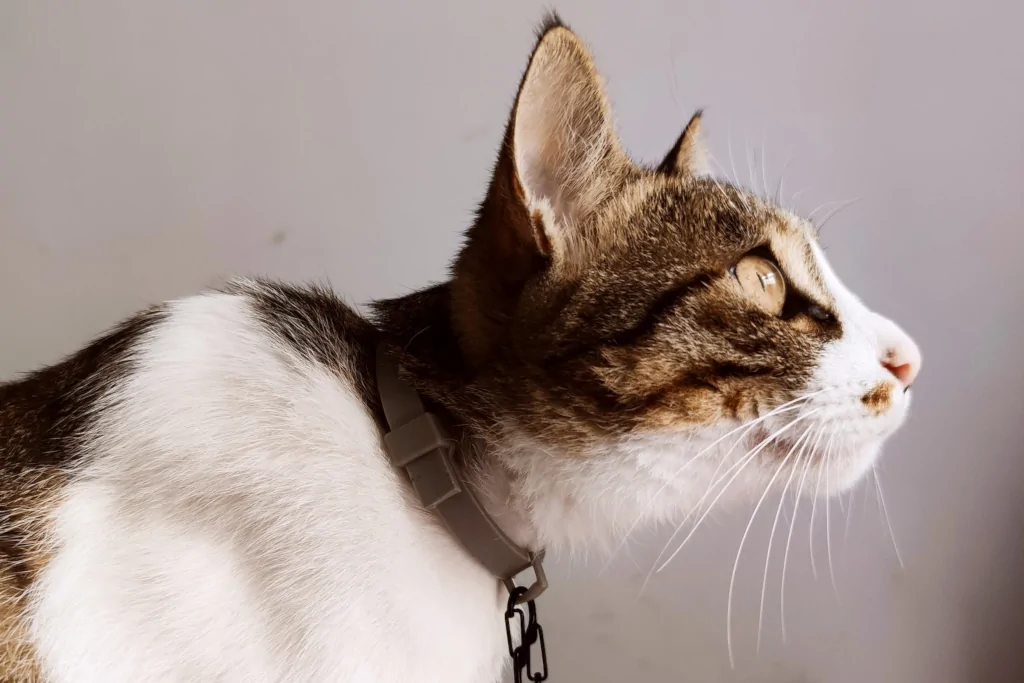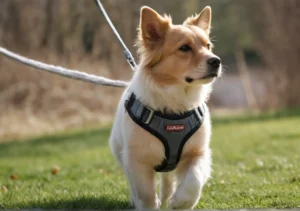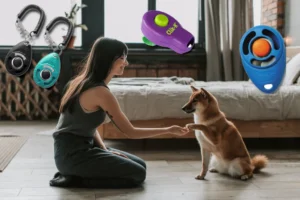Disclosure: We may earn a commission from helpful, relevant links in our content. No cost to you. See our privacy policy.
Introducing a captivating question: can cats wear dog collars? You might be surprised by the answer!
Read on to discover the pros and cons of using dog collars on cats, and find out how to make the right collar choice for your whiskered friend.

Are Dog Collars Safe for Cats? Let’s Find Out
Dog collars are not ideal for cats due to their lack of breakaway features, which pose a safety risk.
Cats are agile creatures, often climbing trees or squeezing through tight spaces, increasing the chances of their collar getting snagged.
Dog collars lack the breakaway feature found in cat collars, which is crucial for cats. Additionally, dog collars may be too heavy or bulky for cats, causing discomfort.
Cats have a unique physiology. Unlike dogs, their tracheas (windpipes) are more delicate, which makes them susceptible to damage from undue pressure. Dog collars, especially those designed for larger breeds, can put excessive stress on this area.
Why Breakaway Features in Cat Collars Are Important
The breakaway feature in cat collars is designed to release the collar under pressure, allowing cats to escape if their collar gets caught on a branch, fence, or other objects.
This simple yet effective mechanism can save a cat’s life, preventing choking or strangulation.
Additionally, it can help reduce the risk of injuries from struggling to break free. It’s essential to prioritize your cat’s safety by choosing a collar with a reliable breakaway mechanism.
Key Differences Between Cat and Dog Collars
Diving into the key differences between cat and dog collars, we can easily see why they’re designed with each species in mind:
- Breakaway Feature. Cat collars are built with breakaway mechanisms that allow the collar to release under pressure. This feature is crucial for cats as they tend to climb and explore, which puts them at risk of getting snagged or caught. Dog collars, however, are designed to be more secure and typically lack this safety feature.
- Size and Weight. Cat collars are generally smaller and lighter than dog collars. They’re designed to be comfortable for cats, who are typically more sensitive to weight and bulk around their necks.
- Reflective Materials. Many cat collars have reflective or glow-in-the-dark elements for added safety during nighttime adventures. While some dog collars also have this feature, it’s more prevalent in cat collars.
- Bells or Accessories. Cat collars often include bells or other small accessories to alert birds and small animals to the cat’s presence, potentially preventing a hunting situation. Dog collars usually don’t have these additions.
- Odor-resistant. Cats are meticulous groomers. Collars made for cats are often designed to resist odor absorption from their regular self-cleaning, ensuring they remain fresh for longer.
To ensure your cat’s safety and comfort, it’s best to choose a collar specifically designed for them, keeping in mind these key differences.
Are There Any Benefits of Using Dog Collars on Cats?
While using dog collars on cats is not recommended due to safety concerns, there may be a few instances where a dog collar could offer benefits.
For example, some dog collars come with more durable materials or built-in GPS tracking, which may be helpful if your cat is an escape artist.
On the other hand, some cats, especially the larger breeds, might benefit from the added durability of a dog collar during rigorous outdoor activities. But even then, the collar’s fit and functionality shouldn’t be compromised.
It’s essential to weigh these benefits against the safety risks and prioritize your cat’s well-being.
Making the Right Choice for Your Cat’s Collar
Selecting the perfect collar for your cat involves considering their safety, comfort, and individual needs. Here are some tips to help you make the right choice:
- Look for a breakaway feature. Ensure the collar has a breakaway mechanism to prevent choking or injuries if the collar gets caught on something.
- Consider size and weight. Choose a collar that is lightweight and appropriately sized for your cat, making sure it’s not too tight or too loose. You should be able to fit two fingers comfortably between the collar and your cat’s neck.
- Material. Opt for a collar made from a comfortable, durable, and non-irritating material such as nylon, leather, or neoprene. Some cats may have allergies or sensitivities to specific materials, so keep this in mind when making your selection.
- Customization options. Some collars come with customizable features like ID tags, charms, or embroidery to help identify your cat if they become lost.
- GPS tracking. If your cat has a tendency to wander, you may want to consider a cat collar with built-in GPS tracking for added peace of mind.
Top Picks for Cat Collars
Here are a few excellent options for cat collars:
- PetSafe KeepSafe Breakaway Collar – This collar features a breakaway buckle that releases when pressure is applied, reducing the risk of choking or injury, and is made from lightweight nylon for comfort.
- Blueberry Pet Essentials Collars – Made from soft and durable neoprene material, this collar is designed to provide maximum comfort and style for your cat with various customization options available.
- BSEEN LED Cat Collar – With a breakaway buckle and LED lights that improve visibility at night, this collar is perfect for keeping your cat safe and seen during evening walks or outdoor adventures.
- Whistle GO Explore GPS Cat Tracker – allows you to track your cat’s location in real-time and set up custom safe zones so you receive alerts when your cat leaves the designated area. The collar is also durable, waterproof, and lightweight.
- Tabcat Cat Tracker – This is a tracker, not a collar itself. However, this GPS cat collar uses advanced RF technology to help you locate your cat in seconds, giving you peace of mind knowing where your cat is at all times.
Remember, it’s always best to prioritize your cat’s safety and comfort when choosing a collar. By considering these factors, you can make an informed decision that will help protect your feline friend.
Which Collars Are Safe for Cats?
Safe collars for cats are those specifically designed for feline needs, with features such as breakaway mechanisms, lightweight materials, and appropriate sizing.
By selecting a cat-specific collar, you’re prioritizing your pet’s safety, comfort, and well-being, ensuring they can explore their world with confidence.
FAQs
Do cat collars need to be a specific size?
Cat collars need to be a specific size that fits your cat comfortably and securely. They should snug but not too tight, allowing for two fingers to fit comfortably between the collar and your cat’s neck.
Can I use a dog leash with a cat collar?
It’s better to use a cat-specific harness and leash for walking your cat, as collars might not provide the necessary support and safety.
Are GPS collars available for cats?
Yes, GPS collars specifically designed for cats are available, providing tracking capabilities for your feline friend’s safety. Look for GPS collars that are lightweight, durable, and comfortable for your cat to wear.
Do cats need time to adjust to wearing a collar?
Yes, cats may need time to adjust, so introduce the collar gradually and monitor your cat’s comfort and behavior.
Alex, a passionate animal lover, has experience in training and understanding animal behavior. As a proud pet parent to two dogs and three cats, he founded AnimalReport.net to share insights from animal experts and expand his knowledge of the animal kingdom.




